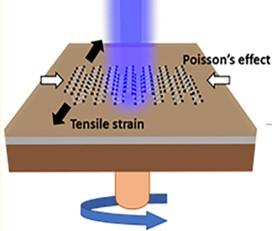
Scientific Achievement
First-principles calculations and Raman scattering measurements reveal that the anisotropic Poisson’s ratio in few-layer black phosphorus (BP) underlies discrepancies reported in literature for trends of Raman shifts with respect to uniaxial strains.
Significance and Impact
A clear understanding of the mechanism for the strain-induced Raman shifts means that it can be used to correlate properties; a step for enabling few-layer black phosphorus as a key candidate for electronics and photonics applications.
Research Details
– Phonon and Raman simulations were performed at CNMS to understand the behaviors of Raman modes in BP under strain.
– Raman measurements were done at UT-Austin to study the phonon response of BP under strain.
W. Zhu, L. Liang, R. Roberts, J.-F. Lin, and D. Akinwande, "Anisotropic electron − phonon interactions in angle-resolved Raman study of strained black phosphorus," ACS Nano 12, 12512−12522 (2018). DOI:10.1021/acsnano.8b06940


